
Abandoned & Little-Known Airfields:
Michigan: Northeast Detroit area
© 2002, © 2016 by Paul Freeman. Revised 11/2/16.
This site covers airfields in all 50 states: Click here for the site's main menu.
____________________________________________________
Please consider a financial contribution to support the continued growth & operation of this site.
Berz Macomb Airport (revised 11/2/16) - McKinley Airport (revised 8/27/16) - Packard Field / Gratiot Airport / Hartung Field / Roseville Airport (revised 7/13/16)
Packard Proving Ground (revised 12/12/11) - Thomas B. Joy Airport / Fraser Airport (revised 12/24/15) - Wings Airport (revised 12/6/11)
____________________________________________________
Thomas B. Joy Airport / Fraser Airport, Fraser, MI
42.53, -82.94 (Northeast of Detroit, MI)

A 9/10/43 aerial view looking north from the 1945 AAF Airfield Directory (courtesy of Scott Murdock & Brian Rehwinkel).
This small general aviation airport may have been established at some point between 1936-43,
as it was not yet depicted on the June 1931 Detroit Sectional Chart
nor on the 1936 USGS topo map (courtesy of Mike Denja).
The earliest depiction which has been located of Thomas B. Joy Airport
was a 9/10/43 aerial view looking north from the 1945 AAF Airfield Directory (courtesy of Scott Murdock & Brian Rehwinkel).
It depicted Thomas B. Joy Airport as having 3 unpaved runways, 2 of which were prominently marked.
Two hangars with checkerboard-painted roofs were at the northwest corner,
along with at least 5 light single-engine aircraft.
The 1945 AAF Airfield Directory (courtesy of Scott Murdock) described Thomas B. Joy Airport
as a 97 acre irregularly-shaped property having 4 cinder runways, the longest being the 2,400' northeast/southwest strip.
Joy Airport was said to have a single metal 60' x 28' hangar & 10 metal T-hangars,
and to be owned & operated by private interests.

Joy Airport was depicted as an commercial/municipal airport on the July 1946 Detroit Sectional Chart (courtesy of Chris Kennedy).

The 1946 MI Airport Directory (courtesy of Mike Denja)
depicted Joy Airport as having 4 cinder or sod runways, and several hangars along the north side.

A circa 1946-48 photo (courtesy of Robert Basista) of his father Edward Basista (3rd from the left) along with an unidentified group in front of a Piper Cub & a hangar marked “Fraser Airport”.

The last aeronautical chart depiction which has been located of Joy Airport
was on the 1949 Detroit Sectional Chart (courtesy of Donald Felton).
It depicted Joy Airport as having a 2,400' unpaved runway.

The last photo which has been located of Joy Airport was a 1949 aerial view (courtesy of Mike Denja).
It depicted a total of 12 light aircraft visible on the field.

The last depiction which been located of Joy Airport was on the 1952 USGS topo map (courtesy of Mike Denja).
It depicted Joy Airport as having 3 runways.
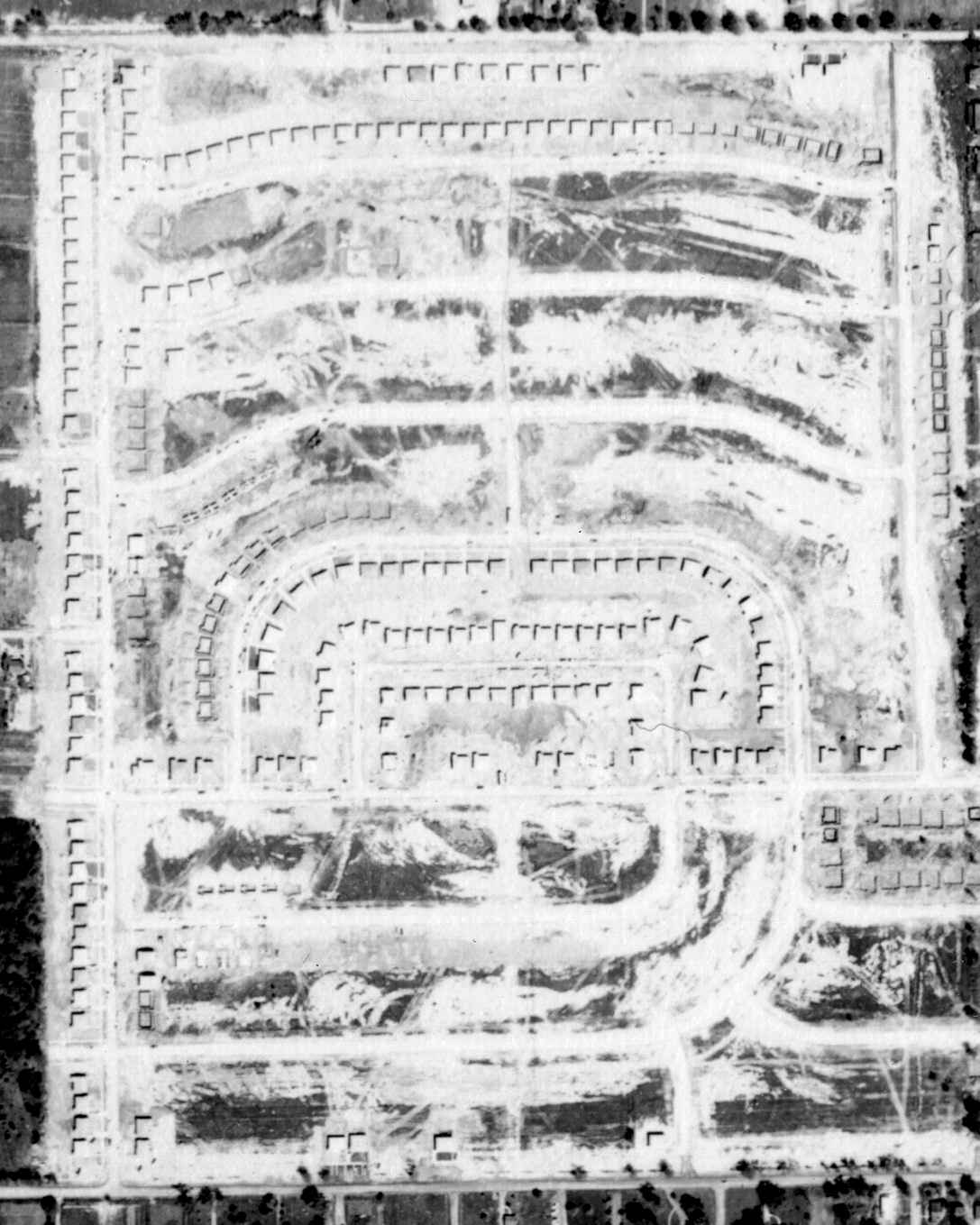
A 1956 aerial view (courtesy of Mike Denja) showed residential construction covering the site of Joy Airport,
but traces of the diagonal runways could still be discerned.
Joy Airport was no longer depicted on the May 1958 Detroit Sectional Chart.
The 1968 USGS topo map showed that Joy Airport had befallen the same fate of so many suburban general aviation airports,
as residential streets covered the site of the airport,
including one named “Airport Road”.

A 2013 aerial view showed no trace remaining of Joy Airport.
Thanks to Mike Denja for pointing out this airfield.
____________________________________________________
Packard Field / Gratiot Airport / Hartung Field / Roseville Airport, Roseville, MI
42.49, -82.94 (Northeast of Detroit, MI)

An undated (circa 1920s) photo of several unidentified biplanes in front of the Packard Aviation Field Hangar #1 (courtesy of Bob Supina).
According to Wikipedia, “Michigan’s first commercial airport, Packard Field, opened at Gratiot Avenue & Frazho Road in 1919.”
The earliest photo which has been located of Pack Field was an undated (circa 1920s) photo (courtesy of Bob Supina)
of several unidentified biplanes in front of a hangar marked “Packard Aviation Field Hangar #1”.

An undated (circa 1920s) photo of several unidentified biplanes & many cars
in front of the Michigan State Aviation School Hangar #2 at Packard Field (courtesy of Miker Denja).
According to Wikipedia, “Packard Field was renamed Gratiot Airport in 1929.”

The only aeronautical chart depiction which has been located of Gratiot Airport was on the June 1931 Detroit Sectional Chart.
In 1934, famous humorist Will Rogers visited the 104 acres then known as Gratiot Airport.

The 1936 USGS topo map depicted Gratiot Airport as a trapezoidal-shaped property having a row of buildings along the southwest side.

The 1940 USGS topo map depicted Gratiot Airport in an unchanged fashion.
Gratiot Airport was later renamed Hartung Field, after the air service company that managed it.
Howard Hartung established a special airport trophy for the women who flew, awarding it 8 consecutive years, from 1936-43.
The trophy bore an image of Howard's daughter Joyce on it.
Annual recognition was given to the most prolific female flyer for abilities in the following categories:
acrobatic, spot-landing, paper-strafing, balloon bursting with propellers, ribbon-cutting, and bomb drops using a sack of flour & a ground target.
"Some of them actually flew their planes in high heels, too," said Gail Elliott.
"Marion 'Babe' Weyant Ruth of the Michigan Women's Hall of Fame was one of them."

A circa 1943-45 aerial view looking north from the 1945 AAF Airfield Directory (courtesy of Scott Murdock)
depicted Hartung Airport as having as single east/west grass runway.
The 1945 AAF Airfield Directory (courtesy of Scott Murdock) described Hartung Airport
as a 100 acre trapzedoidal-shaped property having a sod all-way landing field measuring 2,900' east/west.
Hartung was said to have 5 hangars, the largest being two 60' square wooden structures,
and to be owned & operated by private interests.

The last photo which has been located showing Hartung Airport still open was a 4/16/51 USGS aerial view.
A total of 14 single-engine aircraft were visible on the southwest side of the field, along with a row of hangars.

A 4/16/52 aerial view showing the site of Hartung Airport (courtesy of Mike Denja).
Mike observed, the picture is “Exactly one year to the day after the 1951 aerial.
You can see many new homes already built in that one year.”
According to Wikipedia, “The Eastgate Shopping Center was constructed on the site in the 1950s.”

Inexplicably the 1954 USGS topo map depicted the airport under a different name, “Roseville”,
even though it had evidently ceased to exist for at least 2 years by that point.

A 2014 photo by Bob Supina of the flagpole & plaque at the site of Packard Field.

A 2014 photo by Bob Supina of the 1955 plaque at the site of Packard Field.

A 2014 photo by Bob Supina of the site of Packard Field, now the Eastgate Center shopping plaza.
Thanks to Bob Supina for point out this airport.
____________________________________________________
42.59, -83.06 (Northeast of Detroit, MI)

A postmark commemorating the 9/7/41 dedication of Wings Airport.
This general aviation airport was evidently dedicated on 9/7/41, according to a postmark commemorating the event,
sponsored by the Wings of Detroit Flying Club Incorporated.
According to Darin Ninness, “Wings Field had been formerly been the home to the Polish Flying Club,
and at the outbreak of hostilities in WWII, they handed that airfield over the the Civil Air Patrol 'for the duration'.
CAP used Wings Field for their jumping, along with war bond rallies, cadet encampments, etc.”

The earliest photo which has been located of Wings Airport
was a 1942 photo of a barn on the ground of Wings Airport, with a windsock on top (courtesy of Mark Hess).
Mark reported, “The hangar barn was the [Civil Air Patrol] Michigan Wing Headquarters built in early 1942 at Wings Airport in Utica.”
A 10/4/42 postmark commemorated the “rededication” of Wings Airport (only a year after its dedication).
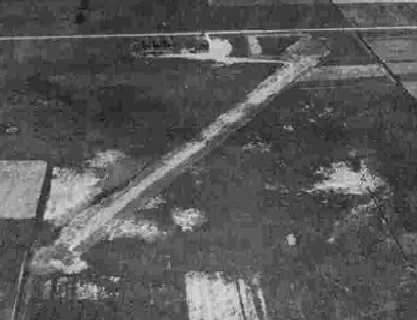
The earliest photo which has been located showing the extent of Wings Airport
was a circa 1943-45 aerial view looking north from the 1945 AAF Airfield Directory (courtesy of Scott Murdock).
It depicted the field as having an unpaved runway.
The 1945 AAF Airfield Directory (courtesy of Scott Murdock) described Wings Airport
as a 152 acre irregularly-shaped property containing 3 sod runways, with the longest being a 2,600' northwest/southeast strip.
The field was said to have a single 120' x 24' wood & metal hangar, and to be owned & operated by private interests.
According to Darin Ninness, “Wings Field apparently faded from CAP's use pretty quickly after the war.”

The earliest aeronautical chart depiction which has been located of Wings Airport was on the 1946 Detroit Sectional Chart,
which depicted Wings as an auxiliary airfield.

The location & layout of Wings Airport as depicted in the 1946 MI Airport Directory (courtesy of Doug Ranz).
It depicted Wings as having 3 unpaved runways, the longest being the 2,600' north/south strip,
with a hangar & administration building on the north side.
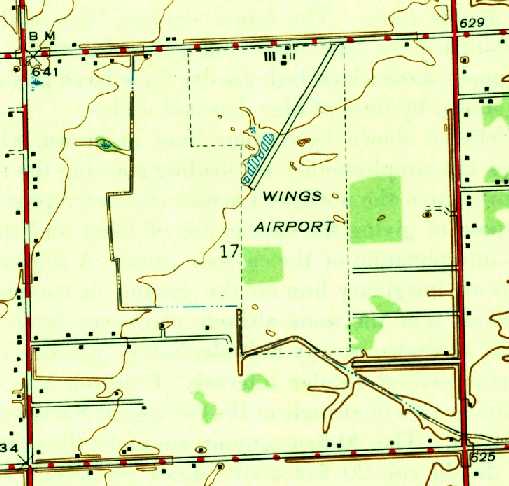
The 1946 USGS topo map (courtesy of Mike Denja) depicted Wings Airport as having a single northeast/southwest runway,
with several buildings along the north side.
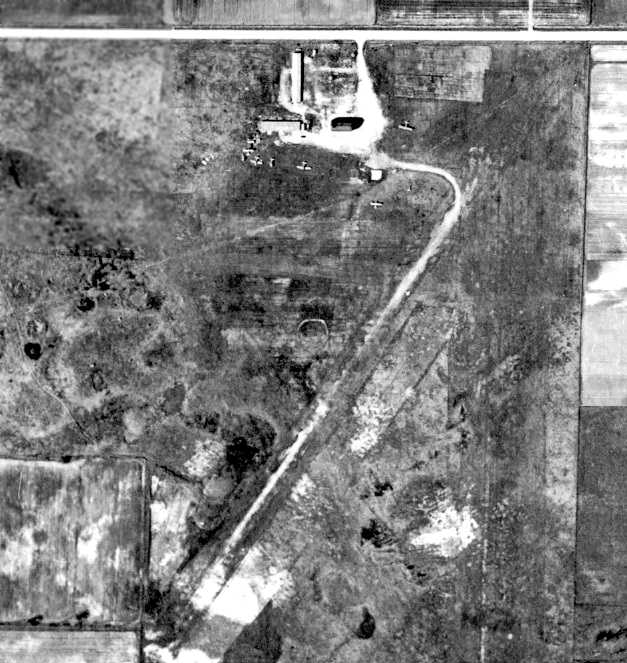
The earliest photo which has been located showing aircraft at Wings Airport was a 1949 aerial view (from the Wayne State DTE collection, courtesy of Mike Denja).
It depicted the field as having 2 grass runways, with a half-dozen light aircraft clustered around a few small buildings on the north end.

The last aeronautical chart depiction which has been located of Wings Airport was on the 1949 Detroit Sectional Chart,
which depicted Wings as having a 2,600' unpaved runway.

The last photo which has been located showing Wings Airport in operation was a 1952 aerial view (from the Wayne State DTE collection, courtesy of Mike Denja).
It depicted the field as having 3 grass runways, and the number of aircraft visible on the field had increased dramatically compared to the 1949 photo.

The 1952 USGS topo map (courtesy of Mike Denja) depicted Wings Airport as having 2 runways,
with several buildings along the north side.

Wings Airport evidently closed (for reasons unknown) at some point between 1949-56,
as a 1956 aerial view (from the Wayne State DTE collection, courtesy of Mike Denja)
showed the runways had been plowed up, but several buildings remained standing.
Mike Denja observed, “The hangar & administration building were still standing in 1967
but finally razed in 1973 when the present development was built.”

A 6/1/07 aerial view showed the site of Wings Airport filled with houses, with not a trace remaining of the former airport.
The site of Wings Airport is located southwest of the intersection of Mound Road & 18 Mile Road.
____________________________________________________
Berz Macomb Airport (UIZ), Utica, MI
42.665, -82.965 (North of Detroit, MI)

Berz-Macomb Airport, as depicted on the November 1972 Detroit Sectional Chart (courtesy of Richard Finley).
No airfield was yet depicted at this location on the 1968 USGS topo map.
According to the Berz Macomb Airport web site,
Milton Berz sold his original airport (what would eventually become today's Oakland-Troy Airport) in 1968,
and the Berz family established the Berz Macomb Airport in 1972.
The earliest depiction which has been located of the Berz-Macomb Airport
was on the November 1972 Detroit Sectional Chart (courtesy of Richard Finley).
It depicted the field as having a single 4,200' paved runway.

The 1973 USGS topo map depicted Berz Macomb Airport as having a single paved northeast/southwest runway, a parallel taxiway,
and a row of T-hangars & 2 smaller buildings on the south side.

The earliest photo which has been located of Berz Macomb Airport was a 1973 aerial view.
It depicted the field as having been constructed with substantial infrastructure,
with a single paved northeast/southwest runway, a parallel taxiway, and a large number of T-hangars.
A total of 19 light aircraft were also visible parked outdoors.
The 1976 Detroit Sectional Chart (courtesy of Mike Keefe)
depicted Berz-Macomb as having a single 4,200' paved runway, and its own NDB navigational beacon.

The May 1977 Detroit Sectional Chart (courtesy of Mitchell Hymowitz)
depicted Berz-Macomb as having a single 4,200' paved runway, and its own NDB navigational beacon.
The 1982 AOPA Airport Directory (courtesy of Ed Drury)
described Berz Macomb Airport as having a single 4,200' asphalt Runway 4/22,
and listed the operator as Berz Flying Service.
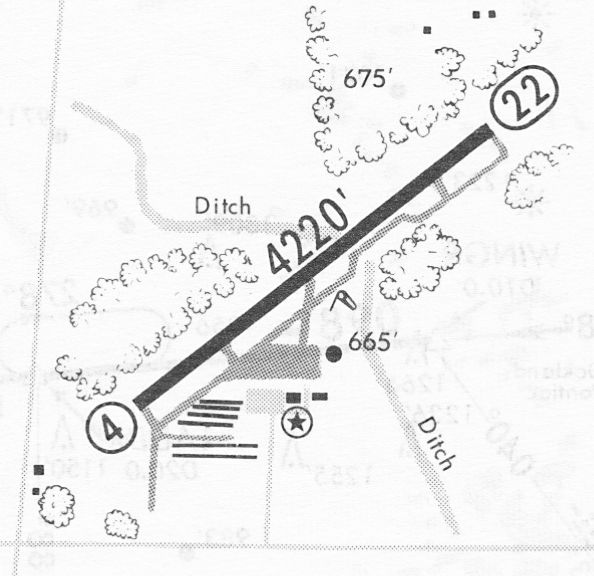
A 6/28/85 airport directory (courtesy of John Kielhofer) depicted Berz Macomb Airport as having a single paved 4,220' Runway 4/22, a parallel taxiway,
and a row of T-hangars & 2 smaller buildings on the south side.

In a 1999 USGS aerial view looking north at Berz Macomb Airport,
a total of only 14 light aircraft were visible parked on the field,
with the majority of the field's parking spots being empty.

An April 2002 aerial view looking north showed the Berz Macomb Airport shortly before its closure.
A total of 14 light aircraft were visible parked on the field, but the great majority of the field's parking spots were empty.
This airport eventually succumbed to the pressures that have become increasingly common
to privately-owned airports surrounded by increasingly dense suburban development.
An article by Mary Owen in the 12/26/02 issue of the Detroit Free Press
was entitled "Berz Macomb Airport hangs in there".
"While developers, courts & planners settle the details of a proposed luxury subdivision on his land,
Milton Berz Jr. is doing business as usual at the Berz Macomb Airport in Macomb Township.
Business is slower now because some customers assume the airport is preparing to close.
For the first time in years, there are empty hangars, and people have been flying elsewhere.
But flying lessons & aircraft hangar space are still available,
and the small office looking onto the runway is full of activity.
Despite plans for 495 luxury homes on the airport's site,
members of the Berz family contend that they're not closing their business any time soon."
"Until the check is in our hands, we're going to be doing business as usual",
said third-generation pilot Jeff Berz.
The article continued, "For 4 years, Farmington Hills-based developer Grand Sakwa
has had an option on the family's 330 acres,
which are between 22 Mile & 23 Mile & Hayes & Romeo Plank.
That means Grand Sakwa has the first option to buy the land.
In exchange, Grand Sakwa pays a yearly fee & pays the airport's property taxes."
The township assessed the land at about $9 million.
The Berz family said Grand Sakwa offered more than that."
"It's one of those situations where property values have increased to the levels
where it doesn't make any sense to run an airport," said Milton Berz Jr.
"To see something you worked at for 30 years ultimately destroyed is not going to be easy."
The article continued, "A court battle between Macomb Township & Grand Sakwa began in 1999
after the township denied the developer's request to rezone the area from industrial to residential.
The township contends that a residential development on the site of the airport goes against its 30-year-old master plan,
even though there's a subdivision opposite the entrance to the airport.
Two years ago, a judge ruled in favor of the developer's request for rezoning.
However, the courts haven't determined whether Grand Sakwa is entitled to several million dollars in damages
as a result of the delay in the project.
Grand Sakwa plans a 190-acre development that would have about 2.6 lots per acre."
"When - and if - the airport does close, it will leave only 2 Macomb County airports:
Romeo State Airport & Macomb Airport in New Haven.
Berz had about 68,200 take-offs & landings in 2001.
Among Berz customers is the Warren Police Department, which stations 2 helicopters there.
Company executives & celebrities such as Bill Cosby & Cindy Crawford
have used the airport when flying into the Detroit area on private jets.
Medical teams transporting organs from St. Joseph's Mercy of Macomb in Clinton Township
also have taken advantage of the nearby facility."
"I think the county is really going to miss this airport," said Jeff Berz.
"They don't realize what they have here."
The article continued, "Jeff Berz, whose wife is working on her pilot's license, said that after the airport is sold,
it will stay open for an additional 90 days to help customers find space elsewhere.
He said people taking flying lessons can transfer their hours.
With a hint of regret, Jeff Berz, who had planned to take over the family business,
says he wishes that the family had developed the land around the airport with restaurants, homes or a golf course.
He said the added revenue could have subsidized the airport."
"I grew up out here," he said. "My father flew me out here when they were bulldozing for the runway."
In 2003, their last year, the Berz Macomb Airport web site described their operation as such:
"Berz Flying Service operates as a full service FBO,
offering flight training, storage, fuel sales, and the maintenance of Piper Airplanes.
The flight department, operating Piper Cherokees, has a unique curriculum,
offering one-to-one training for both ground & flight training."
"Berz-Macomb Airport has a 4,200' paved & lighted runway.
There are both VOR, NDB and GPS instrument approaches, the NDB utilizing a radio beacon on the airport.
There are available most of the amenities to assist you when coming to the Macomb County area.
These include transient hangars & tiedowns, heater service, rental cars, waiting rooms,
nearby restaurants & motels, and both 100 octane & jet A fuel."

Berz Macomb Airport, as depicted in the 2003 MI Airport Directory.
Fred Kaluza reported in 2003, "The Berz Macomb Airport was just sold for a reported $15 million
because it lies smack in the middle of southeast Michigan's fastest sprawling area.
The number one cash crop among area farmers is 'subdivisions'.
It's getting to the point that flying over southeast Michigan is just as hazardous as if you were over the middle of the Pacific.
There's nowhere left to land if you have trouble!"
Russ Shreve recalled, "I took my private check ride with Milt Berz Jr,
and I bought Milt Berz Sr's house when he retired to Florida.
Their flight operation has now moved to Oakland Troy airport,
which oddly enough, formerly was the original Berz Airport the family sold to Rockwell."
A 2005 aerial view showed that sadly, all signs of this well-built modern airport had been erased,
replaced by streets for a new housing development.
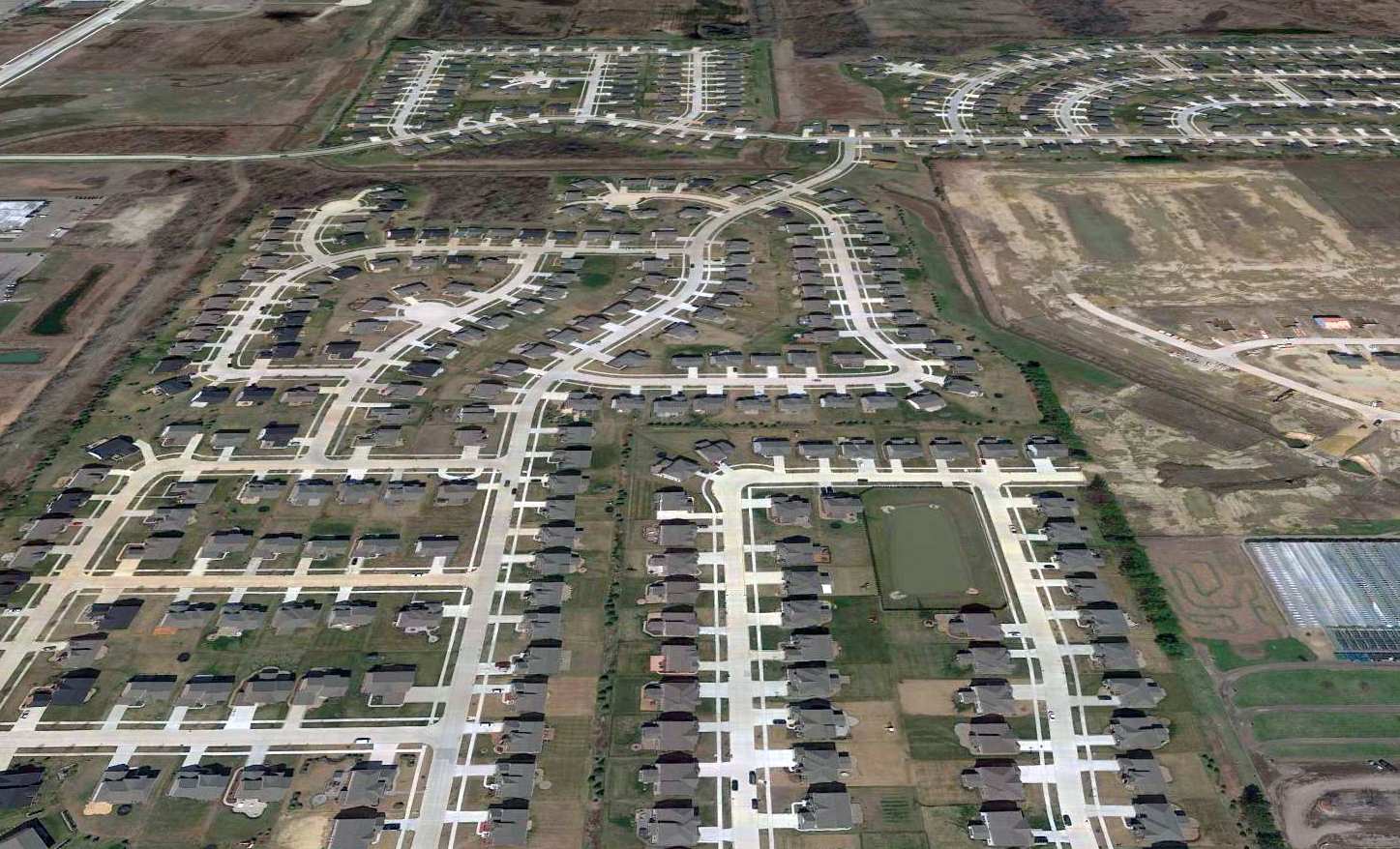
Amazingly a 2016 aerial view looking north showed absolutely no trace remaining of Berz Macomb Airport.
Berz Macomb Airport is located northeast of the intersection of 22 Mile Road & Hayes Road.
____________________________________________________
McKinley Airport (D13), Fraser, MI
42.549, -82.965 (Northeast of Detroit, MI)

McKinley Airport was depicted as an auxiliary airfield on the July 1946 Detroit Sectional Chart (courtesy of Chris Kennedy).
According to Joseph McKinley, McKinley Airport was started by his uncle, the late Otis McKinley, in about 1944.
However, it was not yet depicted on the May 1945 Detroit Sectional Chart (according to Chris Kennedy).
The earliest depiction of McKinley Airport which has been located
was on the July 1946 Detroit Sectional Chart (courtesy of Chris Kennedy).
It depicted McKinley Airport as an auxiliary airfield.
Joseph McKinley recalled, "I spent 3 summers there: 1946, 1949, and 1950,
where in return for flying lessons I worked there - washing airplanes & mowing the grass strips.
He was an Aeronca dealer, and I took my first flying lessons in his Aeronca Champions, at age 12.
I think it was 1946, but it may have been 1947."
The 1946 MI Airport Directory (courtesy of Doug Ranz)
depicted McKinley Airport as consisting of an irregularly shaped landing area, measuring 2,600' x 2,300'.
The 1949 Detroit Sectional Chart (courtesy of Donald Felton)
depicted McKinley Airport as having a 3,200' unpaved runway.

A 1951 issue of "Flying" magazine had an article entitled "The Hangar That Bombers Built" (courtesy of Jerry Sorrell),
which described how Mr. McKinley bought surplus B-17 bomber spars & wing skins
and reused the spars for trusses & the skins for roofing for the hangars built that year at McKinley Airport.

Ercoupes, Cubs, and even a DC-3 are pictured at McKinley Airport
during the construction of the hangar in 1951 (courtesy of Jerry Sorrell).
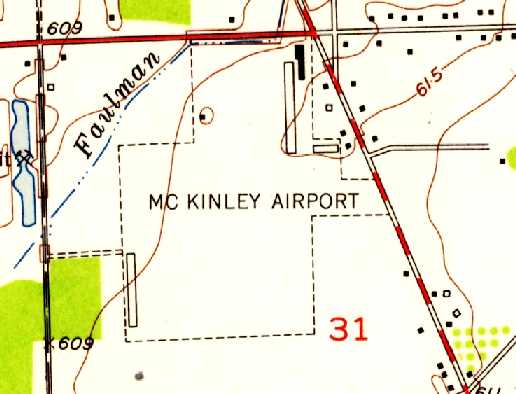
The 1952 USGS topo map (courtesy of Mike Denja) depicted McKinley Airport as having an irregularly-shaped property outine,
with several buildings on the northeast side.

McKinley Airport had apparently gained a paved runway at some point between 1952-60,
as the 1960 Jeppesen Airway Manual (courtesy of Chris Kennedy)
depicted the field as having a single 2,375' paved Runway 9/27 (with a 575' unpaved overrun),
as well as 2 other unpaved runways.
Several long hangars were depicted on the northeast side of the field.
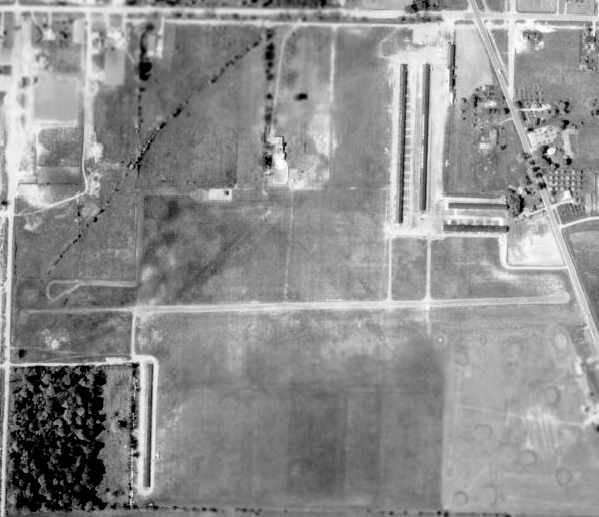
A 1961 Detroit Edison aerial photo of McKinley Airport (courtesy of Mike Denja)
depicted the field as having a single east/west paved runway.
However, also note what appeared to be a turn-around on the west side of a previous alignment of an east/west runway.
Five rows of T-hangars were depicted on the northeast side of the field,
along with another one on the southwest side.
The 1962 AOPA Airport Directory described McKinley Airport
as having 3 runways: 2,600' 18/36, 2,375' 9/27, and 2,300' 6/24.
The operator was listed as Otis McKinley.

An undated (circa 1960s?) photo of a Cessna 172 in front of the McKinley Airport administration building (courtesy of Mike Denja)
The July 1969 Detroit Sectional Chart (courtesy of John Voss)
depicted McKinley Airport as having a single 2,400' east/west paved runway.
The runway at McKinley had been lengthened slightly to 2,900'
by the time of the 1976 Detroit Sectional Chart (courtesy of Mike Keefe).

The May 1977 Detroit Sectional Chart (courtesy of Mitchell Hymowitz)
depicted McKinley as having a single 2,900' paved runway.

The aerial view which has been located of McKinley Airport was a 1977 aerial view.
It showed the airport to be very well-used, with over 40 light aircraft visible on the field.

USGS topo map 1980.
The 1982 AOPA Airport Directory (courtesy of Ed Drury) described McKinley Airport
as having a 2,900' asphalt Runway 9/27 & a 2,600' turf Runway 18/36
(Runway 6/24 had apparently been abandoned).
The operator was listed as McKinley Aviation.

The last photo which has been located of McKinley Airport was a 1984 photo of a variety of light single-engine planes in front of the McKinley Aviation hangar (courtesy of Mike Denja)
McKinley Airport was reportedly purchased by the city of Fraser in 1985,
which then closed the airport in 1987 & sold the property for redevelopment.
A 1999 aerial view showed no trace remaining of McKinley Airport.

A 2016 aerial photo showed the site of McKinley Airport has been heavily redeveloped with housing & other construction,
and not a trace of the former airport appears to remain.
McKinley Airport was located southwest of the intersection of Utica Road & 15 Mile Road.
____________________________________________________
Packard Proving Ground Airfield, Utica, MI
42.66, -83.05 (North of Detroit, MI)
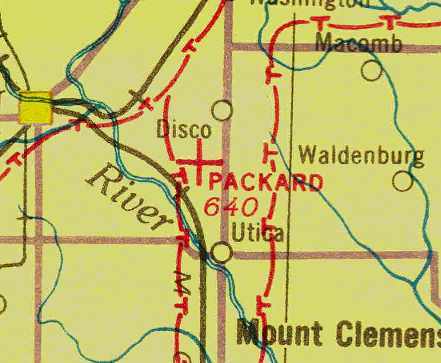
Packard was depicted as an auxiliary airfield on the February 1937 Detroit Sectional Chart (courtesy of Chris Kennedy).
The Packard Motor Car Company Proving Grounds were built starting in 1926.
On a 370 acre site, the company built a 2.5 mile concrete oval automobile test track.
A metal airplane hangar & landing strip were constructed within the oval test track.
The first diesel engine for airplanes was developed here in 1929.
Captain Lionel Woolson, a test pilot for Packard, was killed in a plane crash near Attica, NY
and his ashes were scattered over the Proving Grounds.
Charles Lindbergh landed & visited here on several occasions.
In 1929 he visited the Proving Grounds to fly the Packard Stinson Detroiter, powered by the new radial diesel engine.
After flying the plane he drove the Vincent Speedster around the test track & was clocked at 112 mph.
The earliest aeronautical chart depiction which has been located of the Packard airfield
was as an auxiliary airfield on the February 1937 Detroit Sectional Chart (courtesy of Chris Kennedy).

A circa 1930s aerial view (from Wayne State University's Virtual Detroit website, via Mike Denja)
looking southwest at the Packard Airfield showed the single hangar in the center of the test track.

The 1940 MI Airport Directory (courtesy of Chris Kennedy) depicted the “Packard Proving Ground Field”
as consisting of a 5,000' x 2,000' grass area within the “Superelevated Test Track”,
with a single building on the northwest side of the field.
The field was noted to be for “Emergency Use Only”.
During WW2, the Army used the Proving Ground as an auxiliary airfield.
The types of military aircraft operated from the Packard Airfield have not been determined.
The Proving Ground itself was leased by Chrysler during World War 2 to test tanks & other armored vehicles.
Chrysler constructed a new building on the site that was capable of servicing tanks.

A 9/10/43 aerial view looking north from the 1945 AAF Airfield Directory (courtesy of Scott Murdock)
depicted the Packard Motor Proving Grounds Airfield as a sod field within the test track.
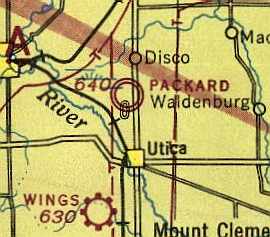
"Packard" was depicted as a military airfield on the October 1943 Detroit Sectional Chart (courtesy of Mike Keefe).

The earliest topo map depiction which has been located of the Packard Airfield was on the 1944 USGS topo map (courtesy of Mike Denja).
It depicted a “Landing Field” (with the propeller symbol used to designate airfields on topo maps of that era) inside the Packard Proving Ground.
The 1945 AAF Airfield Directory (courtesy of Scott Murdock) described the Packard Motor Proving Grounds Airfield
as a 301 acre oval property sod field containing a 5,100' x 2,400' all-way sod landing field.
The field was said to have a single 70' x 50' metal hangar, and to be owned & operated by private interests.

Following the war, the Packard Airfield was once again used as a civilian airfield,
as that is how it was depicted on the July 1946 Detroit Sectional Chart (courtesy of Chris Kennedy).
However, the Packard Airfield apparently closed at some point between 1946-47,
as the December 1947 Detroit Sectional Chart (courtesy of Chris Kennedy)
depicted the oval-shaped "Auto prov track", but no airfield.

1951 aerial view looking southeast at the Packard Proving Grounds.

1952 USGS topo map (courtesy of Mike Denja) depicted the Packard Proving Grounds, but no longer any airfield.
Packard operated the Proving Grounds until 8/15/56,
when the dire financial condition of the Studebaker-Packard Corporation forced it to consolidate all operations at Studebaker’s South Bend, IN facilities.
That same summer, Studebaker-Packard entered into a management agreement
with the Curtiss-Wright Corporation in a last-ditch attempt to avoid bankruptcy.
Curtiss-Wright retained possession of the Packard Proving Grounds after the management agreement with Studebaker-Packard ended in 1959,
as C-W was using Packard’s former engine & transmission plant (located on the northwest corner of the Proving Grounds property)
to overhaul jet aircraft engines, using 50' test cells.
Arthur Boyko recalled, “My dad was in security at the old Packard plant in Detroit until it closed.
The protection department was absorbed by the Curtis-Wright Corporation & was known as the Utica Bend Division.
Dad showed me the test cells that are visible on the Mound Road complex.
Curtis Wright had a contract to overhaul the General Electric J-47 jet engines
that were used on the 6-engine B-47 bomber aircraft.
He told me about the danger involved with the test cells.
Any emergency you had less than a minute to evacuate and, the doors would close and, the CO2 would activate.
Basically you would freeze to death. From what I gather no loss of life ever occurred.”
Curtiss-Wright sold the property to the Ford Motor Company in 1961.
Ford used the former engine plant to manufacture automotive interior trim, known as the Ford Utica Trim Plant .
Ford at various times used the lodge & engineering buildings to make small service runs of prior model year trim parts.
Ford also used the test track for early emission control testing, saving its main test track in nearby Romeo, Michigan for higher-priority testing.
Darin Ninness recalled, “The old Packard Airfield in the 1980s was a happening place for model airplane flying.
The area AMA club used to host a heck of a model fly-in there,
and I spent many summers as a cadet dashing around the infield of that track chasing model rockets & large-wingspan gliders.”
As of the 1990s the former Ford Utica Trim Plant on the northwest portion of the site was transferred to Visteon,
a Ford spin-off.

Recent photo of the Packard hangar.

A 2000 aerial view of the former Packard Proving Ground.

A 2002 aerial view showed that the metal airplane hangar built by Packard still sat in its original location, within the test track,
which also remained intact.

An undated photo of the Packard hangar being relocated.
Mike Montgomery reported in 2003 that the Packard "hangar has been moved
outside the loop of the former test track & closer to the other Proving Grounds Buildings.
The fate of the site is also now secure.
The Packard Motor Car Foundation is acquiring from Ford 2 pieces of the former Proving Grounds -
including the Hangar, 'Lodge', Repair Garage, Engineering Building, Timing Tower and some support structures -
for restoration as an automotive history museum/attraction."
According to the Packard Motor Car Foundation,
"The Lindbergh aircraft hangar has been rescued from the infield
and transported to our 14 acre site where it was securely installed on a new foundation.
It had to be carefully moved between some trees & the Timing Tower to get it onto the property.
This type of small hangar has all but disappeared from the American landscape
and will be one of the few preserved for posterity.
Its connection to a period of industrial growth where Packard branched out into aeronautical & nautical areas
will add further dimension to the historical site."
A 2005 aerial view showed a dramatic transformation of the Proving Ground property within the past 3 years,
with the pavement of the historic oval track having been removed, the hangar having been relocated outside of the track,
and much of the southern portion of the former test track having been covered by development for – what else – more houses.
In 2005, ownership of the former Ford Utica Trim Plant on the northwest portion of the site was transferred back to Ford,
under Automotive Components Holdings LLC.

A circa 2006 aerial view looking north at the relocated Lindberg hangar,
now located just east of the only remaining portion of the original test track.
Note also the timing tower at the bottom of the photo.
The former Ford Utica Trim Plant on the northwest portion of the site was closed in 2009,
as part of the automotive industry's retrenchment.
____________________________________________________
Since this site was first put on the web in 1999, its popularity has grown tremendously.
That has caused it to often exceed bandwidth limitations
set by the company which I pay to host it on the web.
If the total quantity of material on this site is to continue to grow,
it will require ever-increasing funding to pay its expenses.
Therefore, I request financial contributions from site visitors,
to help defray the increasing costs of the site
and ensure that it continues to be available & to grow.
What would you pay for a good aviation magazine, or a good aviation book?
Please consider a donation of an equivalent amount, at the least.
This site is not supported by commercial advertising –
it is purely supported by donations.
If you enjoy the site, and would like to make a financial contribution,
you
may use a credit card via
![]() ,
using one of 2 methods:
,
using one of 2 methods:
To make a one-time donation of an amount of your choice:
Or you can sign up for a $10 monthly subscription to help support the site on an ongoing basis:
Or if you prefer to contact me directly concerning a contribution (for a mailing address to send a check),
please contact me at: paulandterryfreeman@gmail.com
If you enjoy this web site, please support it with a financial contribution.
please contact me at: paulandterryfreeman@gmail.com
If you enjoy this web site, please support it with a financial contribution.
____________________________________________________
This site covers airfields in all 50 states.